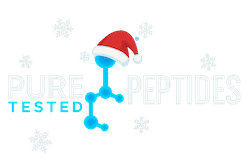LL-37 & SS-31: Potential Synergy Between an Innate-Immunity Peptide and a Mitochondria-Targeted Peptide
This article summarizes what peer-reviewed studies report about the mechanisms of LL-37 (human cathelicidin) and SS-31 (elamipretide), and why researchers consider their pathways potentially complementary. It does not provide dosage guidance or usage recommendations and avoids therapeutic claims.
- LL-37 is an antimicrobial, immunomodulatory peptide involved in chemotaxis, re-epithelialization, and angiogenesis in preclinical and ex vivo models.
- SS-31 is a mitochondria-targeted tetrapeptide that binds cardiolipin, stabilizes cristae structure, improves electron transport efficiency, and can reduce oxidative stress in cell and animal studies; it has clinical investigations in mitochondrial disorders.
- No published studies were found directly evaluating the combination of LL-37 and SS-31; however, their pathways suggest theoretical complementarity at the interface of immune signaling, tissue repair, and mitochondrial function.
LL-37 (Human Cathelicidin): Mechanisms & Research Highlights
LL-37 is the sole human cathelicidin peptide, widely expressed at epithelial surfaces and in neutrophil granules. It displays broad antimicrobial activity and immunomodulatory functions including chemotaxis and cytokine signaling. Reviews and mechanistic studies describe LL-37 as amphipathic and helical, acting on multiple immune receptors and pathways. [oai_citation:0‡PubMed](https://pubmed.ncbi.nlm.nih.gov/16716248/?utm_source=chatgpt.com)
Immune Signaling & Chemotaxis
LL-37 acts as a chemoattractant for immune cells and can signal via formyl-peptide receptors (e.g., FPR2) and other candidates, facilitating leukocyte recruitment and activation. [oai_citation:1‡PubMed](https://pubmed.ncbi.nlm.nih.gov/11015447/?utm_source=chatgpt.com)
Wound Repair & Angiogenesis
In skin injury models, LL-37 is implicated in re-epithelialization, and has been shown to directly stimulate endothelial cells and promote angiogenesis. [oai_citation:2‡PubMed](https://pubmed.ncbi.nlm.nih.gov/12603850/?utm_source=chatgpt.com) [oai_citation:3‡PMC](https://pmc.ncbi.nlm.nih.gov/articles/PMC156109/?utm_source=chatgpt.com)
Context Matters
LL-37’s effects are context-dependent; some studies note pro-inflammatory amplification under certain conditions, underscoring the importance of dose, microenvironment, and disease state in experimental systems. [oai_citation:4‡PubMed](https://pubmed.ncbi.nlm.nih.gov/36614313/?utm_source=chatgpt.com)
SS-31 (Elamipretide): Mechanisms & Research Highlights
SS-31 (also known as elamipretide, MTP-131 or Bendavia) is a cell-permeable tetrapeptide designed to target mitochondria by associating with cardiolipin in the inner mitochondrial membrane. Mechanistic studies report stabilization of cristae architecture, improved electron transport chain efficiency, and reduction of mitochondrial ROS, with downstream effects on bioenergetics. [oai_citation:5‡PubMed](https://pubmed.ncbi.nlm.nih.gov/32273339/?utm_source=chatgpt.com) [oai_citation:6‡PMC](https://pmc.ncbi.nlm.nih.gov/articles/PMC11816484/?utm_source=chatgpt.com)
Preclinical & Translational Findings
Across models of mitochondrial dysfunction, SS-31 has been studied for preserving mitochondrial function and attenuating oxidative stress. Clinical investigations in Barth syndrome (a cardiolipin-related mitochondrial disease) include the TAZPOWER program and natural-history comparisons, reporting safety data and signals on functional outcomes in small populations. [oai_citation:7‡PMC](https://pmc.ncbi.nlm.nih.gov/articles/PMC9388406/?utm_source=chatgpt.com) [oai_citation:8‡PubMed](https://pubmed.ncbi.nlm.nih.gov/38602181/?utm_source=chatgpt.com)
Potential Complementarity: Where LL-37 & SS-31 Pathways Intersect
Direct studies of LL-37 and SS-31 used together were not identified. Nevertheless, several lines of evidence support a plausible, research-oriented rationale for complementarity:
1) Innate Immunity Meets Mitochondrial Signaling
Healthy mitochondrial function is integral to innate immunity, influencing ROS production, inflammasome activity, antiviral signaling (e.g., MAVS), and phagocyte responses. If mitochondrial integrity is preserved, immune signaling can be more precisely regulated. SS-31’s cardiolipin-centric actions may therefore help stabilize the cellular “power and signaling hubs” on which LL-37-responsive immune cells rely. [oai_citation:9‡PMC](https://pmc.ncbi.nlm.nih.gov/articles/PMC4281487/?utm_source=chatgpt.com)
2) Tissue Repair: Angiogenesis, Re-epithelialization & Redox Balance
LL-37 has been linked to angiogenesis and epithelial repair, while mitochondrial bioenergetics and redox control are known modulators of wound closure dynamics. By supporting ATP production and tempering excessive mtROS, SS-31 may create a cellular environment that complements LL-37-associated pro-repair signaling in preclinical contexts. [oai_citation:10‡PMC](https://pmc.ncbi.nlm.nih.gov/articles/PMC156109/?utm_source=chatgpt.com) [oai_citation:11‡PubMed](https://pubmed.ncbi.nlm.nih.gov/12603850/?utm_source=chatgpt.com)
3) Chemotaxis & Cellular Energy Demand
LL-37-driven chemotaxis and immune cell activation impose significant energy demands. Mitochondrial support (as studied with SS-31) could, in principle, sustain these functions while limiting oxidative stress–related collateral damage, a hypothesis consistent with literature linking mitochondria to immune cell performance. [oai_citation:12‡PubMed](https://pubmed.ncbi.nlm.nih.gov/11015447/?utm_source=chatgpt.com)
Summary: The combination is scientifically interesting because LL-37 primarily interfaces with antimicrobial/immune and pro-repair pathways, whereas SS-31 centers on mitochondrial structure–function and oxidative balance—two axes that frequently converge in models of inflammation and tissue repair.
Research-Focused FAQ
Are there human dosage guidelines here?
No. This page provides mechanistic context and literature references only. It does not provide dosing or usage guidance.
Is there clinical research on SS-31?
Yes—particularly in rare mitochondrial disorders such as Barth syndrome (phase 2 and extension studies). Results emphasize safety and exploratory functional outcomes in small cohorts. [oai_citation:13‡PMC](https://pmc.ncbi.nlm.nih.gov/articles/PMC9438322/?utm_source=chatgpt.com) [oai_citation:14‡PubMed](https://pubmed.ncbi.nlm.nih.gov/38602181/?utm_source=chatgpt.com)
Is LL-37 clinically approved?
LL-37 is widely studied preclinically and ex vivo for antimicrobial and immunomodulatory roles; regulatory approvals and clinical use vary and should be verified through official sources and current literature.
Selected PubMed-Linked References
- LL-37 overview & properties: Dürr UHN et al. LL-37, the only human cathelicidin… (2006). [oai_citation:15‡PubMed](https://pubmed.ncbi.nlm.nih.gov/16716248/?utm_source=chatgpt.com)
- LL-37 in re-epithelialization: Heilborn JD et al. J Invest Dermatol (2003). [oai_citation:16‡PubMed](https://pubmed.ncbi.nlm.nih.gov/12603850/?utm_source=chatgpt.com)
- LL-37 as pro-angiogenic: Koczulla R et al. J Clin Invest (2003). Open access. [oai_citation:17‡PMC](https://pmc.ncbi.nlm.nih.gov/articles/PMC156109/?utm_source=chatgpt.com)
- Chemotaxis/immune signaling: Yang D et al. (2000); Tjabringa GS et al. (2006). [oai_citation:18‡PubMed](https://pubmed.ncbi.nlm.nih.gov/11015447/?utm_source=chatgpt.com)
- Context-dependent immune amplification by LL-37: Amagai R et al. (2023). [oai_citation:19‡PubMed](https://pubmed.ncbi.nlm.nih.gov/36614313/?utm_source=chatgpt.com)
- SS-31 mechanism: Mitchell W et al. J Biol Chem (2020). [oai_citation:20‡PubMed](https://pubmed.ncbi.nlm.nih.gov/32273339/?utm_source=chatgpt.com)
- SS-31 review (structure/mechanism/PK): Tung C et al. (2025). Open access. [oai_citation:21‡PMC](https://pmc.ncbi.nlm.nih.gov/articles/PMC11816484/?utm_source=chatgpt.com)
- Barth syndrome studies: Sabbah HN et al. (2021) review; Hornby B et al. (2022) natural-history comparison; Thompson WR et al. (2024) OLE. [oai_citation:22‡PMC](https://pmc.ncbi.nlm.nih.gov/articles/PMC9388406/?utm_source=chatgpt.com) [oai_citation:23‡PubMed](https://pubmed.ncbi.nlm.nih.gov/38602181/?utm_source=chatgpt.com)
- Mitochondria in innate immunity: West AP (2011) review (open access). [oai_citation:24‡PMC](https://pmc.ncbi.nlm.nih.gov/articles/PMC4281487/?utm_source=chatgpt.com)
- Mitochondria in wound healing & redox: Hunt M (2023) review; Sánchez MC (2018) review. [oai_citation:25‡PMC](https://pmc.ncbi.nlm.nih.gov/articles/PMC10523588/?utm_source=chatgpt.com)
